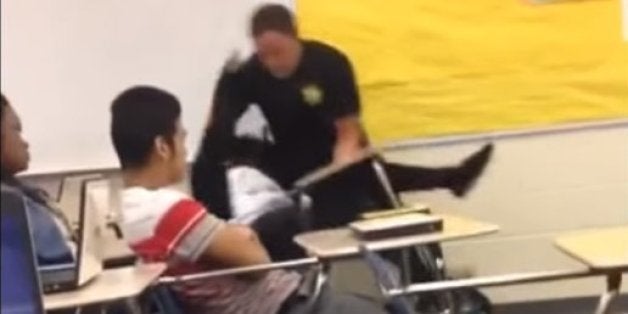
A Black female student's violent assault and arrest by a school police officer at Spring Valley High School in South Carolina has exposed a wider audience to the dangerous consequences of embedding police in schools. While it is not the first video footage of brutality on an unarmed citizen at the hands of police, it is unique because this violent act did not happen on the street during a "routine" police encounter. Instead, it occurred in what we all view as a universal safe haven: a classroom.
The contrast could not be greater with my own experience, twenty years ago, being admonished by my eighth grade teacher for checking my beeper during civics class. My teachers, who were actively invested in my future success and me, didn't treat my actions as criminal. I attended the Piney Woods School, a boarding school for African American students in rural Mississippi, where my sister, parents, and grandfather had all attended. My teachers knew that I had just lost both of my parents to cancer and, even though it was against the rules, I kept the beeper my older sister gave me to ensure I was in constant contact with her. When my world was turned upside down with the loss of my parents, I am certain that the wealth of social support at Piney Woods was a key reason why I was able to stay on a positive course.
Unfortunately for many youth in America, their schools are less like Piney Woods and more like Spring Valley. Their schools do not make them feel safe, nurtured, and supported. High schools are the most powerful institutional force shaping young people's paths toward success or failure, and their life outcomes hinge on whether they are properly educated, supported, and protected. Under the guise of establishing safety, schools have increasingly become an extension of the long reach of the criminal justice system, which begins with police contact. Young people are encountering police in greater numbers at earlier ages, even in environments like schools.
For over ten years I have been intensively studying the impact of the intersecting systems of American public education and the criminal justice system on the lives of urban youth. My work reveals the potent force of our nation's formative social institutions, like schools, on shaping both the life-long attitudes and life experiences of our children. Whether or not these public institutions fulfill their missions to educate, nurture, uplift, and protect our children should be the measure by which we assess our adherence to the American ideals of democracy, fairness, and opportunity.
Regrettably, we are far from meeting those ideals. Findings in my new book, Unequal City, reveal that boys and girls of color are far more likely to reside, learn, and be policed in separate and unequal neighborhoods and schools. Urban high schools, in particular, play a major role in either ameliorating or further reinforcing adolescents' racially divergent social worlds, particularly their perceptions of and experiences with authority figures, such as teachers in school and police officers on the street. Adolescents' perceptions shape decision-making, behaviors, and outcomes, making the social-psychological, educational policy, and urban policy dimensions of this work crystal clear. When young people think their lives will be governed by fair treatment when interacting with authority figures, they are likely to accept even a negative outcome (e.g., punishment, arrest, etc.). When youth confronted by unjust practices fail to perceive injustice but also fail to succeed, they understand their failure to be personal, instead of perceiving race, class, or other social factors as key contributors to social inequality.
My research suggests that transmitting a sense of fair treatment and procedural justice should be central to the organization of authoritative institutions, and duly executed by its actors, especially since young people are often introduced to the criminal justice system without setting foot in a jail or courtroom. By transporting the carceral apparatus of metal detectors, embedded school police officers, and surveillance cameras into our schools, no matter the actual prevalence of violence, we are clearly stating that our priorities lie not in education, but in social control. Now is the time to take stock of the potentially devastating consequences these practices are having on urban communities and our society at large.
We must ask ourselves: what will be the next iteration of American public education? What should be the nurturing arm of the state now looks more like the punishing arm of the state when we see that school police offices act with impunity and can use state-sanctioned excessive force even in the presence of peaceful defiance. We must move away from a focus on discipline and security to one of education and support. A great start would be for the prosecutor in South Carolina to immediately drop charges against the girls and boys who have been prosecuted under the permissibly vague statute of disturbing school. We should now focus on how we make these schools less disturbing to the youth we purport to educate within them.
Carla Shedd is assistant professor of Sociology and African American Studies at Columbia University. She is author of the new book Unequal City: Race, Schools, and Perceptions of Injustice, published by the Russell Sage Foundation.